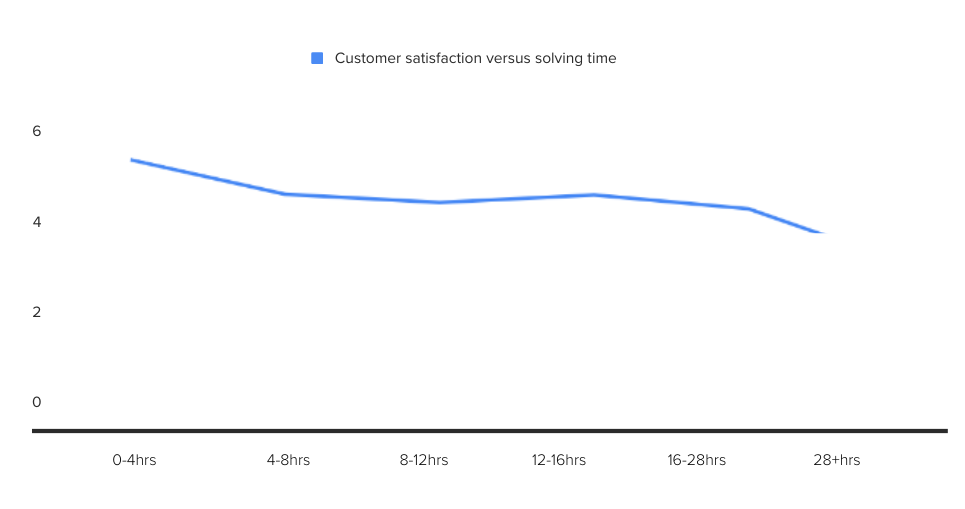Lessons Learned From Over 100 Implementations
As we have seen in the previous blogs of this series, from over 100 Freshworks implementations, there are four universal goals:
- Improved operational control
- Lower customer contact costs
- Improve customer experience
- Enhance the employee experience
In the previous blogs, we discussed achieving more control and reducing customer contact costs. This blog focuses on improving the customer experience.
Improving the customer experience as a main goal
For many of our clients for whom we’ve implemented Freshdesk or Freshservice, improving customer experience is a major objective. There are various ways to define and measure a better customer experience (CX). Whether a company employs customer satisfaction, Net Promoter Score (NPS), Customer Effort Score (CES), or brand experience measurement, the underlying goal often revolves around boosting the future revenue.
Freshdesk and Freshservice provide a range of tools to measure, analyze, and enhance the customer experience. In this blog, we will illustrate this with examples that we have carried out in the field.
Service level influencing the overall satisfaction
In the past, we have encountered instances where service level, average phone wait time, and average email response time were used as indicators of the customer experience. Given that the customer contact department had their doubts about this approach, we researched the relationship between service level and customer satisfaction. In this case, we defined service level as the average time it took to resolve an issue received via email. Customer satisfaction was measured by sending a brief survey two days after resolving the customer’s problem. We asked customers to rate their satisfaction on a seven-point scale.
Customer satisfaction and service level at Parkmobile
We conducted this specific study at Parkmobile, where the average time to resolve customer queries via email was just under two business days. The organisation wanted to improve their service levels, primarily as they believed that this would lead to more satisfied customers.
Surprising data-driven insights
To better understand the relationship, we analyzed all the incoming tickets for which a customer satisfaction survey had been completed. We categorized the data into cohorts based on resolution times: 0 to 4 hours, 4 to 8 hours, and so on. For each cohort, we analyzed the average satisfaction.
The results indeed showed a relationship between resolution time and satisfaction. However, this relationship didn’t mean it was wise to invest in reducing resolution time across all customer contacts. The data revealed little difference in satisfaction within the first 28 hours of resolution time. It was only after this point that average satisfaction began to decline. To enhance satisfaction, we needed to focus on tickets requiring over 28 hours to resolve.

Improving the satisfaction rate was possible by understanding why certain tickets took more than 28 hours to resolve and addressing those underlying causes. For processes that often took a long time to resolve, we introduced a web form to quickly gather all necessary data and provide suitable solutions. This data was readily available from Freshdesk. Without this analysis, we might have heavily invested in faster resolution times across the board, but showing far less improvement in satisfaction.
Benchmark for customer experience as a loyalty predictor
A second example of a project where we aimed to improve customer experience was at Robeco. After completing customer interactions at Robeco, we collected feedback on satisfaction with the interaction, Net Promoter Score (NPS), Customer Effort Score (CES), and perception of brand promises for a subset of contacts. To elaborate, NPS asks about the willingness to recommend the organization to friends and colleagues. CES inquires about how easy it was to obtain a solution to the contacted issue. The brand promises centered around the extent to which customers recognized Robeco in statements such as "Robeco makes investing easy" and "Robeco ensures responsible returns."
Key predictor of loyalty
We used already existing customer survey data to identify the best predictor of future revenue. At Robeco, based on the data, the score on brand values like "Robeco makes investing easy" and "Robeco ensures responsible returns" proved to be the strongest predictor of customers’ future revenue growth. This was followed by Customer Effort Score, then NPS, and finally Customer Satisfaction Score (KTV).
Client promises as an improvement point of the customer journey
Many companies struggle to determine where to focus on, to enhance loyalty and customer experience. Some aim to plot all touchpoints in a customer journey and work on improving touchpoints with the lowest scores. The goal is often to enhance the experience at those touchpoints.
However, we advise to not focus on the weaker points in your customer journey; concentrate on the places where your organization’s brand promises are delivered. These promises have the highest impact on loyalty. If you focus on the weaknesses in the journey, you’re spending your limited resources on becoming a nondescript entity that customers can’t get enthusiastic about.
Change starts with employees
Looking back at Robeco during the customer survey period, as the initial satisfaction survey results came in, we shared them with the team and collaborated with the management team on how to improve the outcomes. While management worked with spreadsheets in meetings, the results started improving rapidly due to small actions taken by the team. These actions included giving compliments to customers, better adherence to commitments, and more effective analysis in conversations.
The most vital lesson: involve the team in everything you do!




